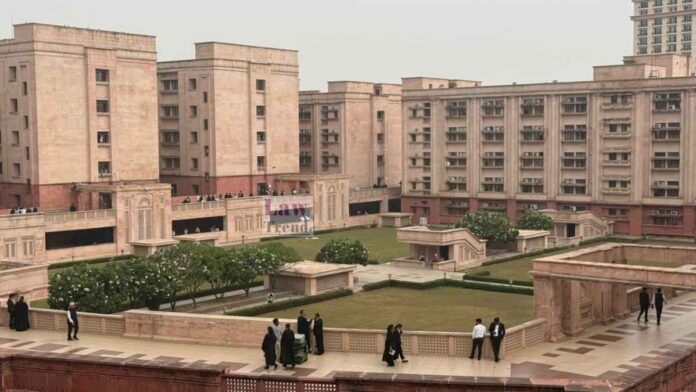The Allahabad High Court (Lucknow Bench) division bench comprising Justice Rajnish Kumar and Justice Rajeev Singh has upheld the life imprisonment sentence awarded to a father for the murder of his 17-year-old daughter, relying on circumstantial evidence and the doctrine of “burden of proof” under Section 106 of the Indian Evidence Act, 1872. The Court affirmed the conviction despite the complainant (the mother) and other family members turning hostile during the trial.
The primary legal issue before the Division Bench was whether a conviction under Section 302 of the Indian Penal Code (IPC) could be sustained based on circumstantial evidence when the eye-witnesses, including the complainant, turned hostile. Specifically, the Court examined the applicability of Section 106 of the Indian Evidence Act, which shifts the burden of proving a fact “especially within knowledge” to the accused, in a case where the death occurred inside the house while the accused was present.
The Bench dismissed the appeal filed by Raju Batham, confirming the judgment of the Additional Sessions Judge, Court No. 9, Unnao, dated July 30, 2016. The Court held that the prosecution had successfully established the chain of circumstances, compelling the appellant to explain the death of his daughter, which he failed to do.
Background of the Case
The prosecution’s case originated from a written complaint filed by Smt. Santosh Kumari Kashyap, the wife of the appellant, at Police Station Ganga Ghat, District Unnao.
According to the complaint, the couple’s daughter, Shivani Kashyap (17), a Class 12 student, was in a relationship with a local resident, Mahesh Nishad. The appellant, Raju Batham, opposed this relationship. On July 7, 2015, Shivani insisted on living with Mahesh, leading to an altercation where the appellant admonished her.
The complainant alleged that in the intervening night between 01:00 AM and 02:00 AM, the appellant strangled Shivani with a cloth string (nada) while she was sleeping. Hearing Shivani’s cries, the complainant entered the room and witnessed the appellant “gagging her neck.” Upon being challenged, the appellant fled the scene. Shivani was declared dead at the District Hospital.
An FIR was registered under Section 302 IPC. The police recovered the murder weapon (cloth string) on the pointing out of the appellant. However, during the trial, the complainant (P.W.-1), her son (P.W.-4), and daughter-in-law (P.W.-5) turned hostile, denying the prosecution story.
Arguments of the Parties
The Appellant’s Submissions: Counsel for the appellant, Mr. Anurag Singh Chauhan, argued that the trial court’s judgment was based on “surmises and conjectures.” He emphasized that the key witnesses of fact had turned hostile. It was submitted that there was no motive for the appellant to kill his daughter and that the conviction relied heavily on Section 106 of the Evidence Act without the prosecution first proving its case beyond reasonable doubt. The defence relied on several judgments, including Boby Vs. State of Kerala (2023) and Nusrat Parween Vs. The State of Jharkhand (2024).
The State’s Submissions: The Government Advocate argued that although the family members turned hostile, the medical evidence and other circumstances pointed solely to the appellant’s guilt. It was submitted that the appellant admitted to being in the house at the time of the incident. Therefore, under Section 106 of the Evidence Act, the burden shifted to him to explain how his daughter died inside the house, a burden he failed to discharge.
Court’s Analysis and Observations
1. Hostile Witnesses and Proof of Complaint The Court noted that while the complainant (P.W.-1) denied lodging the FIR in her court testimony, the prosecution successfully proved the written complaint through P.W.-3 (Rohit Singh), the scribe. P.W.-3 testified that he wrote the complaint on the dictation of the lady (complainant) who then signed it. The Court observed:
“The learned trial Court, after considering the written complaint, has recorded a finding that ‘हस्ताक्षर वादिनी के नाम के है, जो वही है जो इसके साक्ष्यांकन प्रपत्र में है’ (The signature is of the complainant’s name, which is the same as on her attestation form).”
2. Medical Evidence and Recovery The post-mortem report confirmed the cause of death as “Asphyxia due to ante mortem strangulation.” The doctor (P.W.-7) opined that the loop in the neck could not have been self-inflicted. Additionally, the recovery of the cloth string on the pointing out of the appellant was proved under Section 27 of the Indian Evidence Act.
3. Applicability of Section 106, Indian Evidence Act The Court placed significant reliance on the fact that the appellant was present in the house at the time of the murder. In his statement under Section 313 Cr.P.C., the appellant admitted he was sleeping at home but claimed ignorance about how his daughter died.
Citing the Supreme Court judgment in State of Madhya Pradesh Vs. Balveer Singh (2025), the Court reiterated that Section 106 applies when the prosecution proves facts from which a reasonable inference of guilt can be drawn. The Court observed:
“Thus, all the relevant facts showing killing of the daughter of the appellant by him are proved and, admittedly, he was in the house at the time of death of his daughter, therefore, the burden under Section 106 of the Indian Evidence Act, 1872 was on him to prove as to how his daughter had died, which he has failed to prove.”
4. False Explanation by Accused The Court found the appellant’s conduct and explanation suspicious. The appellant claimed he was woken up by the police and informed of the death. However, the Court noted:
“If he was present at home, then who had informed the police about the death of daughter, has not been clarified because the police had not come home and it was the complainant who had reported the incident to police…”
The Court further noted that the appellant’s absence during the inquest (Panchnama) created doubt about his innocence, as he had allegedly run away from the spot as per the initial FIR version.
Conclusion and Decision
The High Court concluded that the chain of circumstances was complete and pointed “only towards the guilt of the appellant.” The Court held that the prosecution had proved the offence beyond reasonable doubt, notwithstanding the hostile witnesses.
Justice Rajnish Kumar, writing for the Bench, held:
“This Court is of the view that the learned trial Court has rightly and in accordance with law has held that the prosecution has proved the offence of Section 302 I.P.C. against the accused i.e. the appellant beyond reasonable doubt… This Court is in agreement with the findings recorded by the learned trial Court as well as the conclusions drawn.”
Accordingly, Criminal Appeal No. 1434 of 2016 was dismissed, and the sentence of life imprisonment was affirmed.
Case Information
- Case Title: Raju Batham vs. State of U.P.
- Case Number: Criminal Appeal No. 1434 of 2016
- Coram: Justice Rajnish Kumar and Justice Rajeev Singh
- Counsel for Appellant: Mr. Anurag Singh Chauhan, Ms. Shameem Jahan
- Counsel for State: Government Advocate







